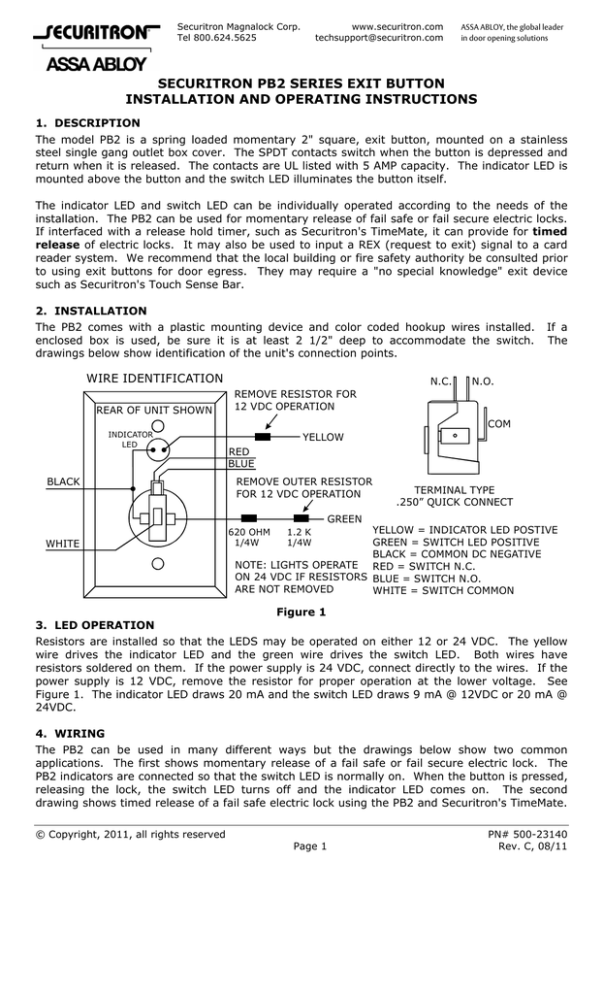
Securitron Magnalock Corp.
Tel 800.624.5625
www.securitron.com
techsupport@securitron.com
ASSA ABLOY, the global leader
in door opening solutions
SECURITRON PB2 SERIES EXIT BUTTON
INSTALLATION AND OPERATING INSTRUCTIONS
1. DESCRIPTION
The model PB2 is a spring loaded momentary 2" square, exit button, mounted on a stainless
steel single gang outlet box cover. The SPDT contacts switch when the button is depressed and
return when it is released. The contacts are UL listed with 5 AMP capacity. The indicator LED is
mounted above the button and the switch LED illuminates the button itself.
The indicator LED and switch LED can be individually operated according to the needs of the
installation. The PB2 can be used for momentary release of fail safe or fail secure electric locks.
If interfaced with a release hold timer, such as Securitron's TimeMate, it can provide for timed
release of electric locks. It may also be used to input a REX (request to exit) signal to a card
reader system. We recommend that the local building or fire safety authority be consulted prior
to using exit buttons for door egress. They may require a "no special knowledge" exit device
such as Securitron's Touch Sense Bar.
2. INSTALLATION
The PB2 comes with a plastic mounting device and color coded hookup wires installed.
enclosed box is used, be sure it is at least 2 1/2" deep to accommodate the switch.
drawings below show identification of the unit's connection points.
WIRE IDENTIFICATION
REAR OF UNIT SHOWN
N.C.
If a
The
N.O.
REMOVE RESISTOR FOR
12 VDC OPERATION
COM
INDICATOR
LED
BLACK
YELLOW
RED
BLUE
REMOVE OUTER RESISTOR
FOR 12 VDC OPERATION
TERMINAL TYPE
.250” QUICK CONNECT
GREEN
WHITE
YELLOW = INDICATOR LED POSTIVE
GREEN = SWITCH LED POSITIVE
BLACK = COMMON DC NEGATIVE
NOTE: LIGHTS OPERATE RED = SWITCH N.C.
ON 24 VDC IF RESISTORS BLUE = SWITCH N.O.
ARE NOT REMOVED
WHITE = SWITCH COMMON
620 OHM
1/4W
1.2 K
1/4W
Figure 1
3. LED OPERATION
Resistors are installed so that the LEDS may be operated on either 12 or 24 VDC. The yellow
wire drives the indicator LED and the green wire drives the switch LED. Both wires have
resistors soldered on them. If the power supply is 24 VDC, connect directly to the wires. If the
power supply is 12 VDC, remove the resistor for proper operation at the lower voltage. See
Figure 1. The indicator LED draws 20 mA and the switch LED draws 9 mA @ 12VDC or 20 mA @
24VDC.
4. WIRING
The PB2 can be used in many different ways but the drawings below show two common
applications. The first shows momentary release of a fail safe or fail secure electric lock. The
PB2 indicators are connected so that the switch LED is normally on. When the button is pressed,
releasing the lock, the switch LED turns off and the indicator LED comes on. The second
drawing shows timed release of a fail safe electric lock using the PB2 and Securitron's TimeMate.
© Copyright, 2011, all rights reserved
Page 1
PN# 500-23140
Rev. C, 08/11
Momentarily pressing the button will release the lock for the amount of time set on the
TimeMate. The indicator will change colors during the lock release period. The wiring is also
done in double break fashion so that even if the timer fails, the button will still be able to
momentarily release the lock. This is for added safety.
MOMENTARY RELEASE OF FAIL SAFE OR FAIL SECURE ELECTRIC LOCK
RED
IF FAIL SAFE
+
IF FAIL SECURE
+
GREEN
POWER
+
WHITE
PB2
BLUE
ELECTRIC
D.C. LOCK
YELLOW
SUPPLY
BLACK
POWER
SUPPLY
+
WHITE
YELLOW
GREEN
TIMED DOUBLE BREAK RELEASE OF FAIL SAFE LOCK
PB2
BLUE
RED
BLUE
YELLOW
WHITE
GREEN
TIMEMATE
BLACK
+
FAIL SAFE
D.C. LOCK
RED
BLACK
5. ALTERNATE LENS CHANGING
The pushbutton is factory shipped with the green lens set installed and two lens/insert options.
Changing to the other lens sets is simple.
1) Grasp keyplate and turn over. From the back rotate the white contact block of the switch
counter-clockwise to the 11 o’clock position and pull straight back to remove the contact
block.
2) With a slender smooth ended object such as a marker pen, slide it inside the switch body
until it stops against the back of the lens. Place the object that is inside the switch body on a
smooth surface with the keyplate on top, and tap the keyplate up and down on the object to
pop the lens off. Remove the lens and insert.
3) Turn the keyplate over and place the new insert onto front of switch, confirm that the text on
the insert is correct reading to the keyplate and place the matching colour lens on top of the
insert and compress around all edges of the lens until it snaps in place. Depress lens several
more times to ensure smooth operation and that the lens is not binding.
4) With the terminals upward insert the contact block back into the back of the switch at the 11
o’clock position and rotate clockwise until it stops straight up and down.
6. LED REPLACEMENT
The switch LED is replaced by grasping the back of the white contact block and twisting it
counter-clockwise to the 11 o’clock position, pull the contact block straight out of the rear of the
switch. This reveals the LED which then can be pulled out from the block. Note: LED is polarity
sensitive. Insert new LED into contacts, the marking on the LED should be on the same side
as the green wire with printing facing the same directions as the switch block terminals.
Operating Life of the switch LED is 100,000 hours. Reverse step to lock contact block back into
switch body.
Page 2
PN# 500-23140
Rev. C, 08/11





